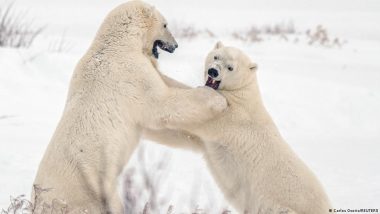Researchers say they have solved the mystery of why dinosaurs shrank to the size of tiny lizards. But with climate change, animals are still getting smaller.If humans were alive 100 million years ago, we would have been constantly hiding from giant animals.
Also Read | SLIM ‘Sniper’ Mission Ready for Moon Landing.
Dinosaurs, such as the Pterosaur, with its 11-meter (36-foot) wingspan, swooped in the skies, while the 15 meter-long Spinosaurus would have chased us down in the plains.
Compare this now to today's largest reptile, their ancestor, the saltwater crocodile, which comes in at a measly 6 meters long.
New research suggests that changes in animal size depends on two key ecological factors: Competition for resources between species and the risk of extinction due to the environment.
"Just like how we try to adapt to hot or cold weather depending on where we live, our research shows animal size can get bigger or smaller over long periods depending on the habitat or environment," said lead researcher Shovonlal Roy, an ecosystem modeler from the University of Reading, in a statement.
The study was published January 18 in the journal Communications Biology.
Animals can shrink or grow over time
Roy and a team of other researchers wanted to challenge an existing theory, known as Cope's Rule, for why animals change size throughout their evolution.
Cope's rule suggests there is a tendency for many animal groups to evolve larger body sizes over thousands and millions of years.
The 19th century paleontologist, Edward Cope, was the first to notice why, for example, early horse ancestors, which were small dog-sized animals, became bigger over time.
But the researchers said Cope's rule had clear exceptions. Reptiles, for instance, shrank from the size of giant dinosaurs to hand-sized geckos and sparrows.
In more recent history, too, Alaskan horses shrank by around 12% between 24,000 years ago and 14,500 years ago when they went extinct.
"Changes in ecological factors help explain why fossil records shows such confusing mixes of size evolution patterns, with some lineages shrinking over time and others growing," said Roy.
Competition and climate influence animal size
Roy and his colleagues used computer models to simulate evolution in different ecological and physiological conditions. They found three different scenarios in which evolution affects body-size.
First, animals increase in size over time. The researchers found that animals grow bigger due to less competition between species when, for instance, there is an abundance of food. This is what happened during the Jurassic period when dinosaurs grew to massive proportions.
"Where direct competition is less, sizes tend to get bigger, even though being really big and few in number can make animals more vulnerable to dying out — such as what happened with the dinosaurs," said Roy.
Second, the model found that some animals get bigger and then go extinct. Big animals, such as dinosaurs and woolly mammoths, grew to meet competitive demands, but then went extinct due to environmental catastrophes or being out-competed by other species.
Third, the model also found the opposite of Cope's rule: that species shrink over time. This happens when competition is high and there is a degree of overlap in habitat and the use of resources.
"In places and times where there's lots of competition between different species for food and shelter, animal sizes often get smaller as the species spread out and adapt to the distribution of resources and competitors. For example, small horses that lived in Alaska during the Ice Age rapidly shrank due to changes in the climate and vegetation," said Roy.
Climate change is shrinking animals now
The study also offers an explanation for why animals are continuing to shrink.
Polar bears have shrunk to two-thirds of their previous size in the past 30 years alone.
And it's not just polar bears — many species of birds, amphibians, and mammals have become smaller over the past century.
Scientists think it's because animals are rapidly adapting to the changing climate.
In 1847, zoologist Christian Bergmann proposed that mammals and birds living in colder climates tended to be larger than those in warmer climates. Bergmann believed that was because larger animals have a smaller surface-area-to-volume ratio, meaning they retain heat better.
That could be why the woolly mammoth grew so large — natural selection favored the larger, cold resistant animals.
But once the planet warmed out of the Ice Age, mammoths struggled to adapt and went extinct, with a little help from human hunters.
Scientists think that now, as the planet heats up, there is a natural selection towards animals becoming smaller. This is especially true for animals in regions experiencing more dramatic temperature rises, such as polar bears in the Arctic.
"Habitat destruction due to climate or environmental changes may amplify these conditions, which may lead to rapid shrinking in animal size and may eventually lead to extinction. Polar bears are clearly facing loss of sea ice and their habitat due to climate change, and extrapolating the findings of our modelling study, it would not be too surprising if they rapidly shrink over time," Roy told DW.
Edited by: Zulfikar Abbany
(The above story first appeared on LatestLY on Jan 18, 2024 04:00 PM IST. For more news and updates on politics, world, sports, entertainment and lifestyle, log on to our website latestly.com).













 Quickly
Quickly












